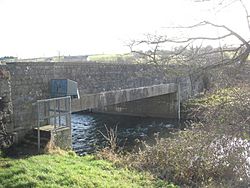Nanny (river) facts for kids
Quick facts for kids Nanny |
|
|---|---|

Duleek Bridge crosses the Nanny
|
|
| Native name | An Ainí |
| Country | Republic of Ireland |
| Counties | County Meath |
| Physical characteristics | |
| Main source | Johnstown village, near Kentstown, Leinster, Ireland 55 m (180 ft) |
| River mouth | Irish Sea Laytown |
The Nanny River, also known as the Nanny Water, is a river in Ireland. It starts near Kentstown and flows into the Irish Sea at Laytown. This river is famous for its trout fishing. Its wide mouth, called an estuary, is a safe home for many birds in winter.
Contents
Exploring the Nanny River's Path
As the Nanny River flows through Julianstown, you can see gray, thick limestone rocks. These rocks are clearly visible and tilt slightly towards the north. Near a place called Rock Bellew, you can also spot bluish-gray limestone cliffs along the river.
The river makes interesting turns near Dardistown bridge. It also bends again near St. Columbkille's Well. A bit further north from the well, you can see more limestone rocks. These rocks look similar to those found at Rock Bellew. Near where the Nanny River begins, there are piles of gravel. There's even a long ridge of gravel, about two miles long. This ridge is made of limestone pebbles and layers of sand.
Fishing for Trout in the Nanny
Long ago, a story says that Saint Patrick was not happy with some rivers in Meath, including the Nanny. He supposedly put a curse on them because they did not have enough fish. However, today the Nanny River is full of wild trout. It is also stocked with brown trout, which means more brown trout are added to the river. These brown trout make up more than half of all the fish caught each year.
The best time to catch trout is from March to May. There is a special area near Bellewstown where you can only fish using a fly. This is called fly fishing. Some sea trout also swim up the river from the estuary.
The Nanny River Through History
The Nanny River has played a part in Irish history. According to an old story, in 848, a leader named Cineadh joined forces with the Norsemen. They fought against Malachy and took over churches and lands. A year later, Malachy's people drowned Cineadh in the Nanny River. Back then, the river was known as the Ainge.
During the Irish Rebellion of 1641, an important battle happened at the Nanny Water crossing in Julianstown. This was called the Battle of Julianstown. An English army was on its way to help in the first siege of Drogheda. But Irish rebels strongly defeated them at the river.
Later, during the Williamite Wars, another important event happened. After the Battle of the Boyne, the Jacobite army had to retreat. They headed for the bridge at Duleek to cross the Nanny River and escape.
Wildlife and Nature of the Nanny Estuary
The part of the Nanny River that meets the sea is called an estuary. This estuary stretches for about 3 kilometers (about 2 miles). It is a very important place for birds that spend the winter there. The European Union protects this area under its Birds Directive.
The estuary is narrow and sheltered, which means it's a great home for waterbirds. Birds like golden plovers, oystercatchers, ringed plovers, and sanderlings find shelter here in winter. Other birds that live here include brent geese, bar-tailed godwits, great black-backed gulls, common gulls, Eurasian curlews, dunlins, and great cormorants.
The main channel of the estuary goes about 2 kilometers (about 1.2 miles) inland. It is narrow and protected, with soft, muddy ground. This area has both salty marshland and freshwater marshland. There are also some wet grassy areas. The salty marsh is most noticeable on the eastern side of the channel.
Plants like sea plantain, sea aster, red fescue, and sea purslane grow in the salty marsh. Deeper into the estuary, you can find plants like bulrush and yellow flag. The shoreline, which is about 500 meters (about 1,640 feet) wide at low tide, includes sandy beaches and areas covered by water at high tide.
Images for kids








